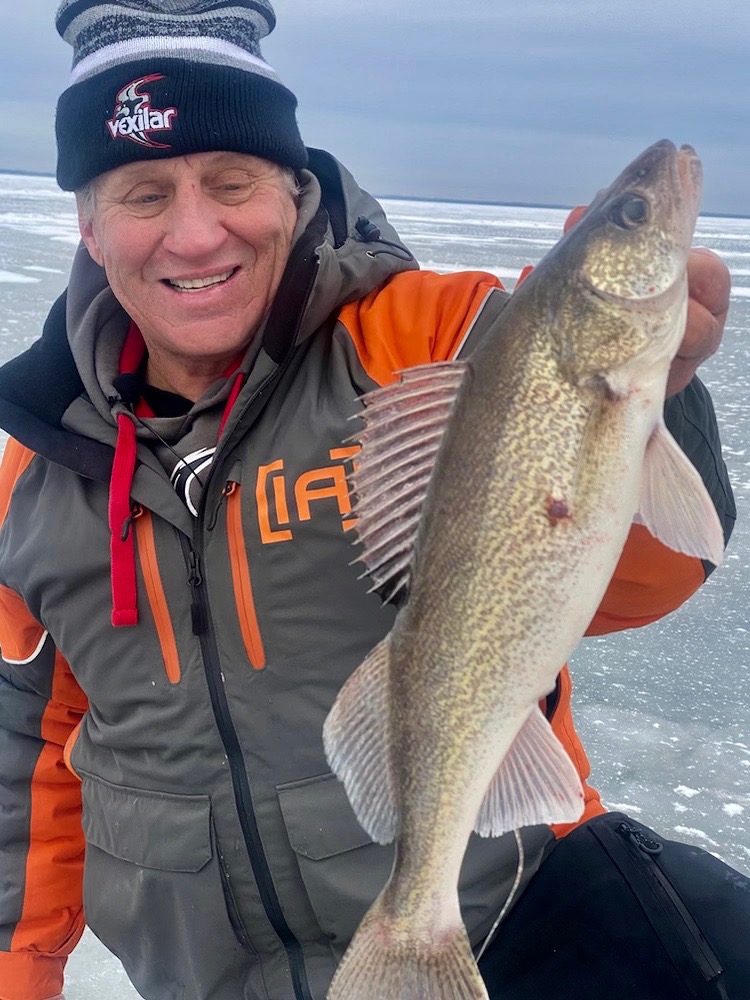Spoons for Walleyes!

WALLEYES ON SPOONS THROUGH THE ICE
by Bob Jensen
Walleyes will respond to a number of different lure types under the ice, but they especially like to eat spoons. There are a bunch of different types of spoons available to walleye anglers. Although they may look similar, there are some differences, and there are a few things you should consider when you’re deciding what spoon to tie onto the end of your line. Here are some of those considerations.
Consider water clarity. In cloudy water where the fish can’t see as far, a noisy spoon like a Rattlin’ Blade Spoon will get the walleye’s attention. The rattling noise coming from the spoon will help walleyes find the bait easier when their sight is limited.
In clear water the rattling noise isn’t as necessary, but it still doesn’t hurt. However, if you’re fishing clear water and see fish on your sonar come in and look at your lure but not eat it, and if you’re using a rattling lure, switch to a spoon that doesn’t rattle. A quiet lure, at times, will be more productive, especially in clear water.
Consider the color of the spoon. Again, clear or cloudy water will have a bearing on what color to start with. Clear water: Something natural in appearance.
Cloudy water: Go with something brighter, something that will be more visible in limited visibility conditions. If you have a “glow” lure, give it a flash of light and put it down there. I’ve seen lots of times when a “glow” lure out-produced anything else.
And, again, if the fish are looking but not eating, try something else. Sometimes bright lures perform very well in clear water.
If you’re fishing walleyes that have been getting a lot of fishing pressure, try something way different. Fish become conditioned to a particular presentation. If everyone is doing the same thing and it’s not working, try something else.
Think about the physical size of your lure. In stained water a larger spoon will be easier to see, so a large lure will often be more productive.
When the fish are finicky, a spoon that’s smaller in appearance will often be better.
Sometimes a spoon that has more action as it falls will be more appealing to walleyes and any other fish that might be in the area. This is where a spoon like the Leech Flutter Spoon excels. It’s made of zinc, it’s very thin, and it has a unique flutter as it falls.
Also consider the line you’re using. In deep water a no-stretch line will provide outstanding sensitivity and hooksets. However, no-stretch lines are more visible, and some anglers think that the added visibility can spook the fish. For that reason, they tie a small swivel to the end of the no-stretch line, then tie twelve to twenty inches of monofilament or fluorocarbon to the other end of the swivel. To the other end of the mono or fluoro a small snap is attached. Your spoon is attached to the snap. With this rigging you have outstanding feel, hooksets, and invisibility. The swivel also prevents line twist.
Something that adds taste and smell is usually hung on the spoon. A piece of a minnow will almost always get more walleyes to eat your spoon.
Spoons catch walleyes and a variety of other fish as well. Give them a try this winter. If there are fish in the area, and if those fish are even a little interested in eating, show them a spoon. A spoon with hooks on it.
Photo Caption—Spoons are great walleye baits, but Kyle Thomsen catches lots of largemouth bass on spoons also.

